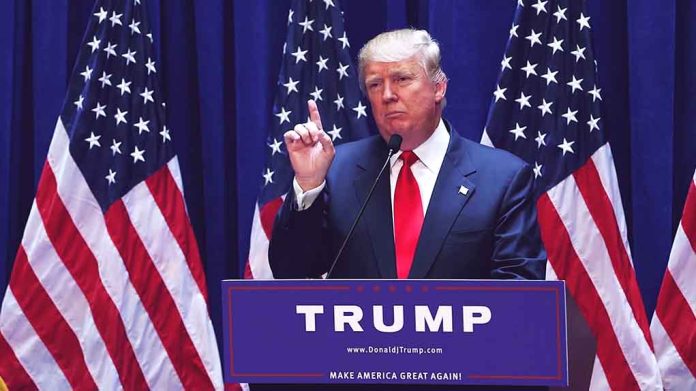🔴 Website 👉 https://u-s-news.com/
Telegram 👉 https://t.me/usnewscom_channel
President Trump bans federal funding for gain-of-function research in countries like China, potentially preventing another pandemic like COVID-19, which many believe originated from a lab leak at the Wuhan Institute of Virology.
Key Takeaways
- Trump’s executive order halts federal funding for gain-of-function research in nations with inadequate biosafety protocols, specifically targeting countries like China and Iran.
- The order directs U.S. research agencies to stop funding biological research that poses threats to public health, safety, or national security.
- Health and Human Services Secretary Robert F. Kennedy Jr. noted that gain-of-function research has yielded no positive outcomes while posing significant risks.
- The action comes amid ongoing concerns that COVID-19 originated from a lab leak at the Wuhan Institute, which received U.S. funding through EcoHealth Alliance.
- The order includes a temporary pause on certain research within the U.S. until safer policies can be developed within 120 days.
Securing America Against Lab-Created Pandemic Threats
President Trump has taken decisive action to prevent future pandemic threats by signing an executive order that ends federal funding for dangerous gain-of-function research in countries with inadequate oversight. This significant policy change directly targets research similar to that conducted at the Wuhan Institute of Virology before the COVID-19 outbreak. The order specifically prohibits U.S. federal dollars from supporting potentially hazardous biological research in nations like China and Iran, which have been identified as engaging in such research, potentially for warfare purposes.
The executive order empowers U.S. research agencies to terminate funding for any biological research that threatens public health, safety, or national security. It establishes stronger enforcement mechanisms and enhanced reporting requirements to prevent policy evasion and ensure proper oversight. This comprehensive approach addresses what the administration identified as significant gaps in previous policies that lacked adequate enforcement, transparency, and oversight, allowing dangerous research practices to continue with minimal scrutiny under previous administrations.
COVID-19 Origin Concerns Driving Policy Change
Trump’s action directly addresses concerns about the origins of COVID-19, which many scientists and officials believe may have resulted from a lab leak. Over $1.4 million in U.S. grants were funneled through EcoHealth Alliance to the Wuhan Institute of Virology for research on bat coronaviruses between 2014 and 2021, according to reports from the New York Post. This funding connection has raised serious questions about American tax dollars potentially contributing to research that may have led to the global pandemic that devastated economies and claimed millions of lives.
“President Trump has long theorized that COVID-19 originated from a lab leak at the Wuhan Institute of Virology and has consistently pushed for transparency in investigating its origins,” according to The White House.
White House Secretary Will Scharf emphasized the connection between this research and the pandemic, stating, “Many people believe that gain-of-function research was one of the key causes of the COVID pandemic that struck us in the last decade.” Trump himself reinforced this view at the signing ceremony, saying, “It’s a big deal. It could have been that we wouldn’t have had the problem [with COVID-19] had we done this.” This executive action fulfills one of Trump’s campaign promises to address what many conservatives view as a critical national security vulnerability.
Expert Support for Research Restrictions
The administration’s position is bolstered by expert opinions on the dangers of gain-of-function research. Dr. Jay Bhattacharya, a prominent health policy expert who gained recognition during the pandemic, strongly supported the order, stating, “The conduct of this research does not protect us against pandemics, as some people might say.” He further explained that this type of research actually creates risks of accidental leaks that could trigger pandemics rather than prevent them, representing a fundamental shift in how the federal government approaches bioresearch security.
“If one of these pathogens is released accidentally or if they are released deliberately, they can cause pandemics,” said Richard Ebright, a chemical biologist at Rutgers University.
Health and Human Services Secretary Robert F. Kennedy Jr., who has been outspoken about vaccine safety and pharmaceutical industry practices, noted that countries such as China, Russia, and Iran are actively engaged in gain-of-function research with potential military applications. Kennedy emphasized that throughout history, this type of research has not produced any beneficial outcomes that justify its inherent risks. The administration’s policy reflects this risk-benefit analysis, prioritizing public safety over uncertain research benefits.
Balancing Safety and Scientific Progress
While primarily focused on stopping dangerous international research, the executive order also establishes a temporary pause on certain types of gain-of-function research within the United States until safer policies can be developed. The Office of Science and Technology Policy and the National Security Advisor have been directed to create these enhanced safety protocols within 120 days. This approach aims to find a balance between protecting Americans from dangerous pathogens while ensuring the U.S. maintains leadership in biotechnology and biosecurity innovation.
Some scientists have expressed concerns that the restrictions could impede important research. “If we ban it, the next time another COVID virus comes through, we won’t have the data to quickly find new treatments, screening, and even preventative measures,” argued Kristin Matthews, a fellow in science and technology policy at Rice University’s Baker Institute. However, the administration maintains that the order focuses specifically on the most dangerous research while allowing beneficial scientific inquiry to continue under proper oversight, representing a measured approach to a complex scientific and security challenge.
